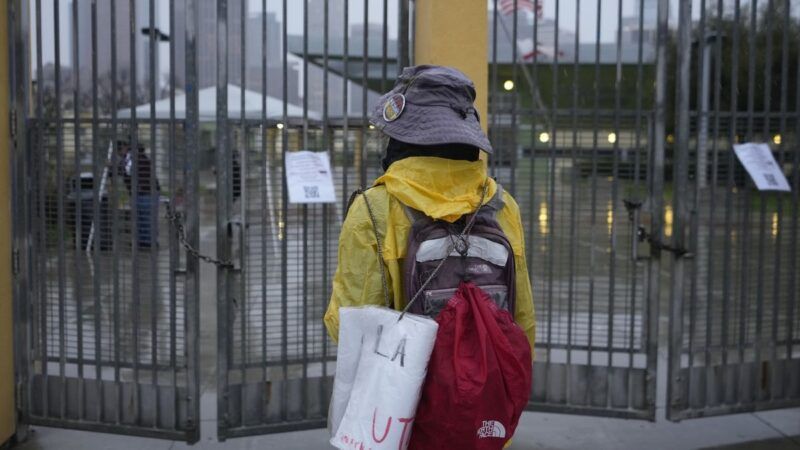Teachers Union Closes L.A. Schools Yet Again
Public sector unions squeeze final gains out of a district that's been bleeding students yet constructing expensive new buildings for two decades.

The Los Angeles Unified School District (LAUSD), the country's second-largest, closed its doors Tuesday on the first of a three-day solidarity strike by teachers who are backing a 30 percent pay raise plus $2 per hour "equity wage adjustment" for custodial workers represented by the powerful Service Employees International Union (SEIU).
Keeping kids locked out of schools has become quite the specialty for United Teachers Los Angeles (UTLA). The union struck for six days over contract negotiations in January 2019, then successfully pressured LAUSD leadership to keep school buildings closed for more than a year after the COVID-19 pandemic hit, despite Southern California's famously temperate and ventilatable weather.
Still more students would have been turned away from the schoolhouse doors had the pesky legal system not gotten in the teachers' way. In the fall of 2021, as part of the long-awaited full reopening of government-run public schools, the LAUSD imposed one of the nation's only vaccine mandates on students ages 12 and up. That requirement was scheduled to be backed by the physical barring of an estimated 34,000 unvaccinated students in December 2021, but the district postponed enforcement at the last minute, then was successfully sued by the parent of a non-compliant 12-year-old.
A few setbacks notwithstanding, the UTLA received a remarkable number of pandemic-era concessions—an extra $500 monthly childcare stipend, mandatory weekly testing of students and staff, outdoor masking requirements, and so on.
In completely related news, LAUSD schools are facing chronic absenteeism, "astounding declines in academic performance," and consecutive-year enrollment drops of 4 percent, 6 percent, and 2 percent, which—because school funding is tied to enrollment numbers—is setting up the district's budgetary situation to be what Superintendent Alberto Carvalho has described as "Armageddon" and "a hurricane of massive proportions."
The enrollment wipeout has been numerically awesome to behold. Twenty years ago, LAUSD peaked at 747,000 K-12 students, almost all of whom were taught by the government-managed, union-staffed monopoly. By 10 years ago, that was down to 656,000, of which 567,000 (or 86 percent) were in traditional schools, the rest in independently run charters. Now LAUSD-run schools educate just 422,000 kids, and charters are up to 113,000.
Reduced birthrates, slowed immigration, family-unfriendly housing prices and stalled population growth all contribute to the shrinking of the student pool, but as the charter explosion attests, families that have the option of escaping their unionized school are taking it. And untold thousands of kids are just plain missing.
What makes the post-2002 enrollment cliff-dive not just an advertisement against public sector unionism but an injustice-generating citywide catastrophe of boneheaded central planning, is that the LAUSD embarked on a $20 billion, eminent-domain-abusing school-construction frenzy—characterized as "the largest public works project in the western United States"—right around 2002. Hundreds of businesses, more than a thousand residents of affordable housing, the historic Ambassador Hotel and beloved Hollywood Star Lanes (of The Big Lebowski fame) … all bulldozed out of the way by government in order to educate non-existent kids.
"The impact on this town is monumental," then-school superintendent Roy Romer gushed about the building spree to the overly credulous L.A. Times in 2004. "It is literally going to change the face of Los Angeles." Not in the way that he and virtually all of L.A.'s political class intended.
You might think that UTLA would be a tad more shy about once again closing down their horridly performing, increasingly unpopular schools whose dwindling student body bears the scars of the past three lousy years. That is, if you haven't been paying attention to teachers unions. The best that can be said about this week's outrage is that it hastens the evacuation from government-run K-12, the shrinkage of available funding for unionized teaching jobs, and the explosion of school choice. Hope those short-term payouts were worth that long-term institutional self-destruction.
Related: "What Really Drove Los Angeles Teachers to Go on Strike."
Show Comments (49)